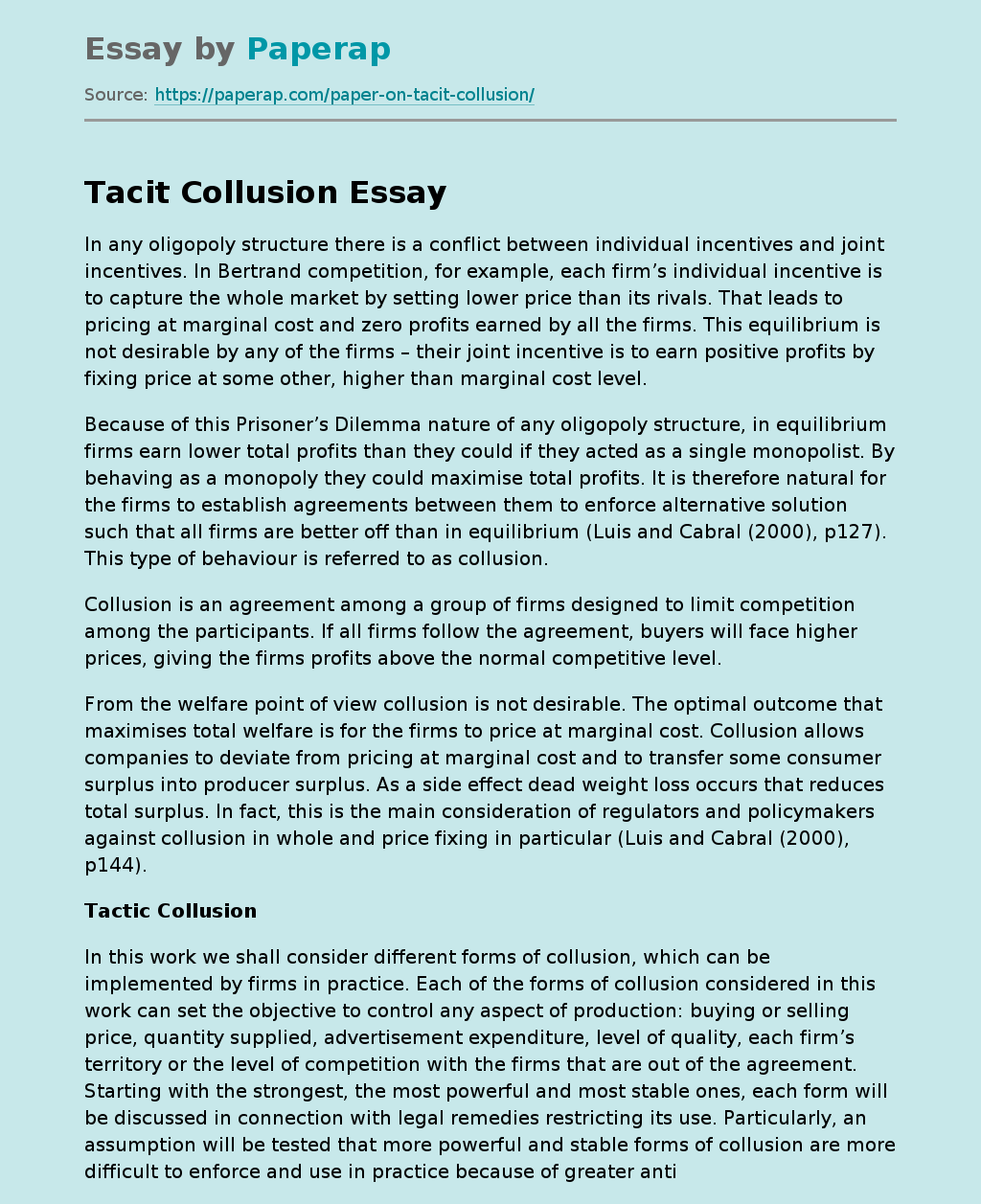Tacit Collusion Forms of collusion
In any oligopoly structure there is a conflict between individual incentives and joint incentives. In Bertrand competition, for example, each firm’s individual incentive is to capture the whole market by setting lower price than its rivals. That leads to pricing at marginal cost and zero profits earned by all the firms. This equilibrium is not desirable by any of the firms – their joint incentive is to earn positive profits by fixing price at some other, higher than marginal cost level.
Because of this Prisoner’s Dilemma nature of any oligopoly structure, in equilibrium firms earn lower total profits than they could if they acted as a single monopolist. By behaving as a monopoly they could maximise total profits. It is therefore natural for the firms to establish agreements between them to enforce alternative solution such that all firms are better off than in equilibrium (Luis and Cabral (2000), p127). This type of behaviour is referred to as collusion.
Collusion is an agreement among a group of firms designed to limit competition among the participants.
If all firms follow the agreement, buyers will face higher prices, giving the firms profits above the normal competitive level.
From the welfare point of view collusion is not desirable. The optimal outcome that maximises total welfare is for the firms to price at marginal cost. Collusion allows companies to deviate from pricing at marginal cost and to transfer some consumer surplus into producer surplus. As a side effect dead weight loss occurs that reduces total surplus.
In fact, this is the main consideration of regulators and policymakers against collusion in whole and price fixing in particular (Luis and Cabral (2000), p144).
In this work we shall consider different forms of collusion, which can be implemented by firms in practice. Each of the forms of collusion considered in this work can set the objective to control any aspect of production: buying or selling price, quantity supplied, advertisement expenditure, level of quality, each firm’s territory or the level of competition with the firms that are out of the agreement. Starting with the strongest, the most powerful and most stable ones, each form will be discussed in connection with legal remedies restricting its use. Particularly, an assumption will be tested that more powerful and stable forms of collusion are more difficult to enforce and use in practice because of greater antitrust restrictions.
Full cartel is behaving very much like monopoly, controlling all aspects – price, output, investment, product mix and profits. Less complete cartel, often called the marketing cartel controls all its members’ sales and revenues (Shepherd (1979), p307).
The most well known example of cartel is the Organisation of Petroleum Exporting Countries (OPEC). It is an international organisation consisting mainly of oil-rich Middle East Arab countries2. It has a significant power in determining the world oil prices by controlling its members’ joint oil production. It first achieved success in 1973 by raising the world oil price from $3 to $11, and then to about $30 in 1979.
The Diamond Cartel, DeBeers, is another well-known example. It has a significant power of control over world diamond industry. Now more than 80% of the world’s diamonds are processed through DeBeers’s Central Selling Organization. In 1981, it flooded the diamond market to punish one of its members for defecting from the cartel and managed to reduce the price form $3 to $1.80 3
Among all types of collusion cartel is the strongest and most stable one. It is the most powerful in terms of determining the price or any other aspect a cartel controls. For this reason cartels are largely illegal (in Europe by Article 85 of the Treaty of Rome; by Sherman Act in the United States). So, if firms want to communicate directly, they may do so secretly.
Secret agreements are illegal also, but these agreements are less obvious than cartels. It takes a great deal of effort to detect if a price change, for example is a result of agreement between companies or it is just due to the demand change. Secret agreements are easier to implement than to form a cartel. For this reason, firms have an incentive to make secret agreements to fix the price that would maximise their joint profits or to control any other aspect like quantity, advertisement etc.
One recent example of secret agreements is a case of credit card firms colluding to compete against debit card rivals. Visa and MasterCard actively discouraged the use of rival debit cards to push the use of their own more expensive versions, raising costs for merchants and customers (see Appendix 1). If this anticompetitive behaviour is proved, firms will be heavily penalised.
Another recent example of illegal secret agreement is commission fees fixing by two well-known auction houses. A fine of �20.4 million has been imposed by The European Commission on the auction house Sotheby’s for colluding with its rival Christie’s. The EU case against the auction houses follows action in the United States where Sotheby’s was sentenced to pay $45 million. Christie’s escaped both EU and US fines because it provided evidence to European and American investigators that enabled them to prove the existence of the agreement.4
Secret agreements are very risky in the sense that once the existence of such agreements is detected and proved, it may result in fines or jail time. In real world, a lot of firms seeking to collude do not want to bear such a risk. Therefore, they have to find some other ways to communicate with each other.
Tacit Collusion Forms of collusion. (2019, Dec 05). Retrieved from https://paperap.com/paper-on-tacit-collusion/

